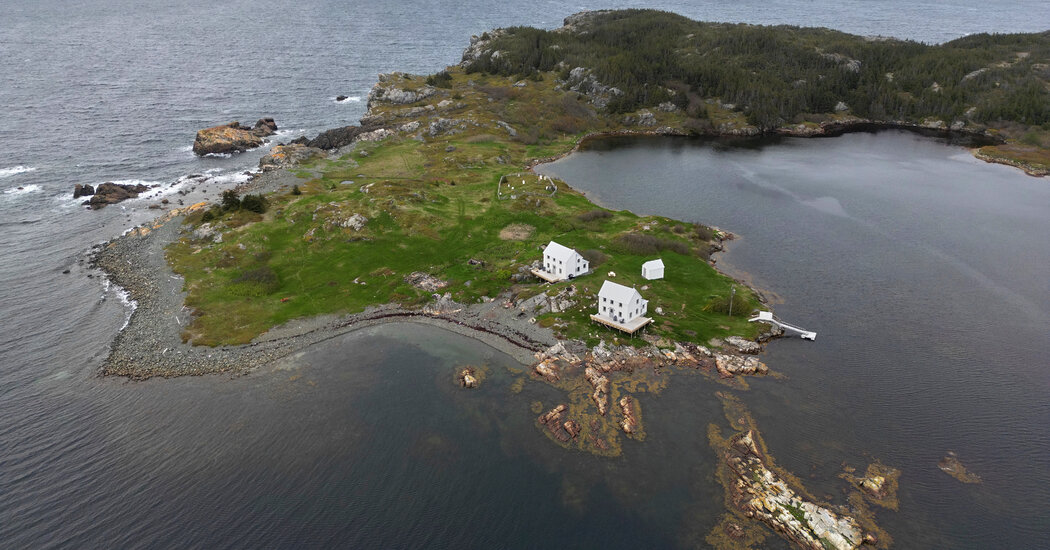When Cailey Heaps wants to get away from it all, one place comes to mind: the island of Newfoundland in Canada.
Although she spends most of the year in Toronto, where she runs the real estate brokerage Heaps Estrin and raises her three children — 17-year-old Mimi and 13-year-old twins Declan and Pippa — the craggy, saltwater-sprayed eastern coast of Newfoundland has long held special appeal.
“It’s this very romantic, peaceful part of the world where it feels like time moves at a different pace,” said Ms. Heaps, 47. “I can go there for three days and feel like I’ve taken a two-week holiday.”
In 2021, she was considering buying a country house within an easy drive of Toronto, but the siren song of Newfoundland beckoned. Diving into the listings, she was surprised to find one with a pair of the most quintessential Newfoundland saltbox houses she’d ever seen.
The two white houses, built in 1912 and 1914, were on a property in Salvage, a tiny coastal town with a population of 108, along with three red sheds, a small cemetery and an outhouse at the end of a dock with a hole directly above the water. The parcel was across the harbor from the center of town, on Burden’s Point, but highly visible, and it had been on the market for years. It had even been the subject of news stories focused on worries that the houses might be torn down.
Stuck in Toronto, Ms. Heaps asked her friend and Newfoundland real estate agent Chris O’Dea what he thought of it. “Chris said, ‘Cailey, this is a big project. It’s not what you’re picturing. It’s a massive undertaking. There’s no road access. It’s boat and foot access only,’” Ms. Heaps said. “But I thought to myself, ‘Oh, how bad can it be?’”
She decided to buy it without seeing it in person after a local contractor told her that the buildings could likely be restored for about 250,000 Canadian dollars ($184,000). She closed in March 2022 for 235,000 Canadian dollars ($173,000). Then she asked Reflect Architecture, a Toronto-based studio run by Trevor Wallace, to breathe new life into the structures.
“We went out there to check them out,” Mr. Wallace said. “And, just like with anything that old, there were a lot of surprises.”
Upstairs, the ceilings were about six feet high, so he couldn’t even stand up. Much of the wooden clapboard siding was so soft you could poke a finger through it. The sheds looked ready to topple over.
“Everything was very rickety,” he said. “They had just had a hundred years of good old Newfoundland battering.”
Back in Toronto, Mr. Wallace began drawing up plans to update the two houses and make them comfortable for a new generation, while retaining as much character as possible. The plan was to use the larger, 1,060-square-foot house, which had no electricity or plumbing, as the main living space and Ms. Heaps’s primary suite. The 915-square-foot house — which had a few modern touches, like electricity and a flushing toilet — would become sleeping quarters for her children and a media room.
The architects took pains to preserve the buildings’ exterior appearance: They added new white clapboard siding that mimics the original siding and standing-seam metal roofs. They maintained the original window openings but, inspired by the Canadian painter Christopher Pratt, added new energy-efficient window units with deep jambs to create more striking shadows on sunny days. They added a new window to Ms. Heaps’s bedroom that looks out toward the water and isn’t visible from town, and designed wraparound decks.
Inside, the upstairs ceilings were pushed into the attics for more headroom, and layers of wallpaper were peeled away to reveal the original wood paneling. And new rough-hewed wood was installed in areas where the original paneling turned out to be oddly shaped scraps of leftover lumber.
To give the houses a simple, stylish look while keeping costs down, they got creative with paint. Most of the interiors are painted white, but various saturated colors — muddy gray, forest green, royal blue, peachy pink — define the staircases and bedrooms. The streamlined kitchen has birch plywood cabinets and counters made of butcher block.
Outside, they restored one of the sheds to serve as a future artist’s studio and dismantled the other two, along with the outhouse. Because there is still no road, all of the building materials had to be brought in and out by boat.
Even with such basic material choices and compromises, the construction cost more that Ms. Heaps expected. By the time the work was complete in May 2023, it had ballooned to about 1 million Canadian dollars ($735,000) — quadruple the initial estimate. But it’s money well spent to Ms. Heaps, who is recouping some of her investment by renting out the property on Airbnb when she isn’t using it.
“It’s the most unique setting I’ve ever seen,” she said. “You go out the back door, up the hill and come to a lookout where all you see is ocean, trees and whales. It’s a magical place.”
For weekly email updates on residential real estate news, sign up here.


